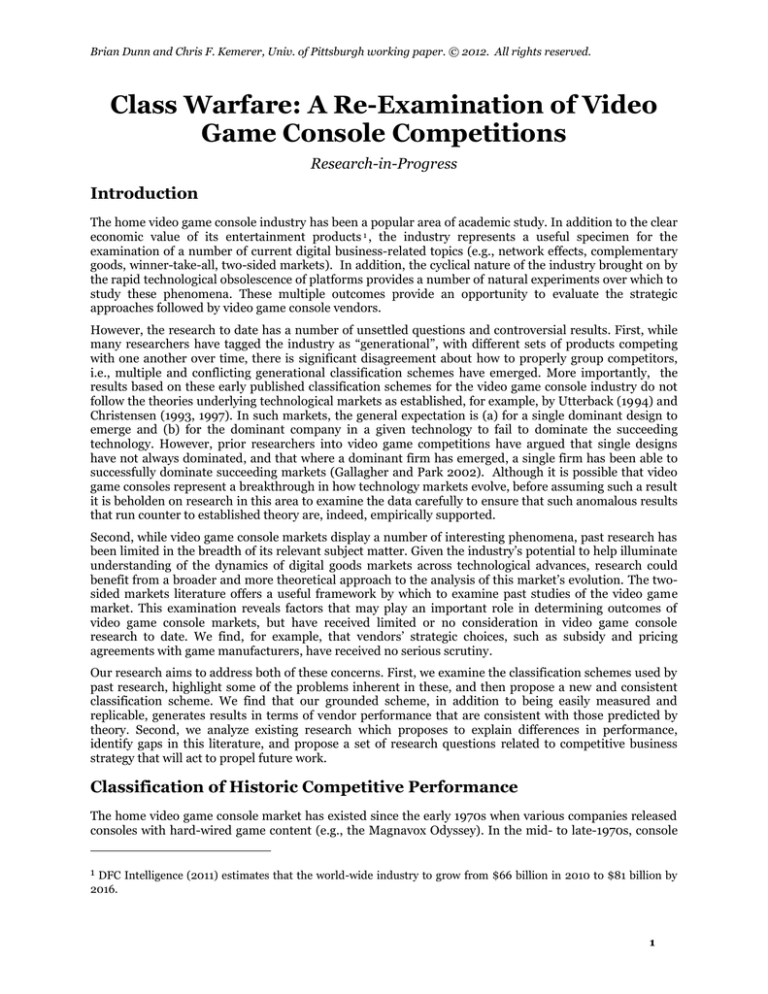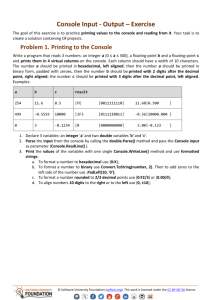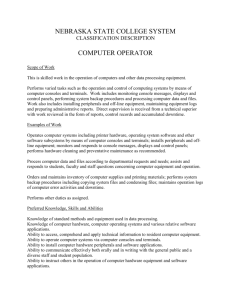
Brian Dunn and Chris F. Kemerer, Univ. of Pittsburgh working paper. © 2012. All rights reserved.
Class Warfare: A Re-Examination of Video
Game Console Competitions
Research-in-Progress
Introduction
The home video game console industry has been a popular area of academic study. In addition to the clear
economic value of its entertainment products 1 , the industry represents a useful specimen for the
examination of a number of current digital business-related topics (e.g., network effects, complementary
goods, winner-take-all, two-sided markets). In addition, the cyclical nature of the industry brought on by
the rapid technological obsolescence of platforms provides a number of natural experiments over which to
study these phenomena. These multiple outcomes provide an opportunity to evaluate the strategic
approaches followed by video game console vendors.
However, the research to date has a number of unsettled questions and controversial results. First, while
many researchers have tagged the industry as “generational”, with different sets of products competing
with one another over time, there is significant disagreement about how to properly group competitors,
i.e., multiple and conflicting generational classification schemes have emerged. More importantly, the
results based on these early published classification schemes for the video game console industry do not
follow the theories underlying technological markets as established, for example, by Utterback (1994) and
Christensen (1993, 1997). In such markets, the general expectation is (a) for a single dominant design to
emerge and (b) for the dominant company in a given technology to fail to dominate the succeeding
technology. However, prior researchers into video game competitions have argued that single designs
have not always dominated, and that where a dominant firm has emerged, a single firm has been able to
successfully dominate succeeding markets (Gallagher and Park 2002). Although it is possible that video
game consoles represent a breakthrough in how technology markets evolve, before assuming such a result
it is beholden on research in this area to examine the data carefully to ensure that such anomalous results
that run counter to established theory are, indeed, empirically supported.
Second, while video game console markets display a number of interesting phenomena, past research has
been limited in the breadth of its relevant subject matter. Given the industry’s potential to help illuminate
understanding of the dynamics of digital goods markets across technological advances, research could
benefit from a broader and more theoretical approach to the analysis of this market’s evolution. The twosided markets literature offers a useful framework by which to examine past studies of the video game
market. This examination reveals factors that may play an important role in determining outcomes of
video game console markets, but have received limited or no consideration in video game console
research to date. We find, for example, that vendors’ strategic choices, such as subsidy and pricing
agreements with game manufacturers, have received no serious scrutiny.
Our research aims to address both of these concerns. First, we examine the classification schemes used by
past research, highlight some of the problems inherent in these, and then propose a new and consistent
classification scheme. We find that our grounded scheme, in addition to being easily measured and
replicable, generates results in terms of vendor performance that are consistent with those predicted by
theory. Second, we analyze existing research which proposes to explain differences in performance,
identify gaps in this literature, and propose a set of research questions related to competitive business
strategy that will act to propel future work.
Classification of Historic Competitive Performance
The home video game console market has existed since the early 1970s when various companies released
consoles with hard-wired game content (e.g., the Magnavox Odyssey). In the mid- to late-1970s, console
1 DFC Intelligence (2011) estimates that the world-wide industry to grow from $66 billion in 2010 to $81 billion by
2016.
1
Brian Dunn and Chris F. Kemerer, Univ. of Pittsburgh working paper. © 2012. All rights reserved.
platforms such as the Atari 2600 (VCS) began to appear, the functionality of which could be extended
through the purchase of additional complementary content (i.e., games). Since then video game consoles
have followed the same basic paradigm in which manufacturers build and sell the console, and primarily
third parties develop and sell games that can be played on a compatible console.
Video game consoles are subject to significant obsolescence, and console extensibility has generally been
limited. While peripherals, such as external drives and motion-sensing controllers, have occasionally been
added to existing consoles, these consoles remain nevertheless limited by the technology already on board
(e.g., the speed of the processor). As technology improves, it becomes possible for games to become more
detailed and content-rich; however without new consoles on which to play these games, game players
cannot take advantage of such improvements. Thus, over time consoles become obsolete and are replaced
with consoles that implement newer, more powerful technology. As a result, platform competitions
emerge with the rise of a new technology and end with the onset of succeeding technologies; i.e., these
competitions have clear beginnings and ends, and each has a limited number of participants.
The past literature has proposed a variety of conflicting ways by which to classify the various video game
consoles into discrete competitions (see Figure 1). This in itself raises the question as to which scheme is
the most appropriate or suitable for future research2.
Figure 1. Comparison of Video Game Console Competition Classification Schemes
For example, the TurboGrafx console introduced in 1989 is characterized as “fourth-generation” by
Gallagher and Park (2002), is omitted by Corts and Lederman (2008), is considered “second generation”
(along with earlier consoles like the 1985 Nintendo NES) according to Gretz (2010), but “third generation”
2 Note that some prior research in the area focuses on a discrete set of consoles (e.g. Srinivasan and Venkatraman
(2010)) and avoids this potential problem.
2
Brian Dunn and Chris F. Kemerer, Univ. of Pittsburgh working paper. © 2012. All rights reserved.
by Gretz (2010a). Similarly, the 1995 Sony Playstation is both Gallagher and Park’s and Corts and
Lederman’s “fifth generation”, but is “third generation” and “fourth generation”, respectively, in Gretz
(2010) and Gretz (2010a), and “32-/64-bit generation” by both Chintagunta et al. (2009) and Dubé et al.
(2010).
However, more problematic than the confusing variety of schemes and labels is the fact that it can be
difficult to assess these schemes in terms of the criteria used to establish the boundaries. For example, the
earliest of these studies, Gallagher and Park (2002), recounts the historical competitions in the video
game console industry. The authors identify six generations, with the onset of a new generation defined by
the sole requirement of “a minimum of 100% improvement” in graphics capability (2002, p. 70). This
classification scheme raises two significant concerns, however. First, generations are ambiguously
defined; it is not clear what is meant by “100% improvement” in graphics capability. Second, there is no
argument proposed for why this is necessarily an appropriate single criterion.
More troubling, however, is that the adoption of this approach yields several anomalous results. Prior
theory in the evolution of technology markets and the importance of network effects and complementary
goods suggests that markets such as the one for console video games will have so-called “winner-take-all”
outcomes (Utterback 1994; Arthur 1989; Katz and Shapiro 1985). However, the Gallagher and Park
classification yields some anomalous results: their “fourth generation” yields two winners, the Sega
Genesis and the Nintendo SNES consoles. Their classification also shows the Sony Playstation and the
Nintendo 64 as co-winners of the “fifth generation” (Gallagher and Park, Table VI, p. 78).
One additional concern from these Sony/Nintendo “fifth generation” winners is that Gallagher and Park’s
scheme results in Sony also winning the authors’ “sixth generation”. There is considerable research and
empirical evidence from Christensen and others that true generational shifts are the result of disruptive
technologies, and that winners in one generation are very rarely the winner in the succeeding generation
(Christensen 1993, 1997; Henderson and Clark 1990).
In order to address the issue of ambiguity and to possibly rectify the discord between existing
classification schemes and theoretical expectations for competitive outcomes, we offer a new classification
system (see Figure 2 and Table 1). Our system is based on two key factors, a primary classifier and a
secondary one. The primary classifier is processor word length, and, within this, a secondary criterion is
the time between world-wide release dates. The logic behind this approach is first that processor word
length has been a widely used technical metric to define computing power. Processors with longer word
lengths, all else being equal, will have superior performance to shorter word length machines. This has
resulted in a monotonic growth path for processor word length. It is also potentially disruptive in that
systems software, e.g. operating systems, often requires significant modification in order to take
advantage of the new longer word length offered by the hardware. Therefore, this is a natural break point
between what we term classes of consoles. Second, we recognize that word length, although useful, may
not capture all of the technical advancements that take place in the hardware, particularly in cases where
improvements in word size happen more slowly. Therefore, we add a second dimension to the
classification criteria of time between world-wide release dates. The passage of time is essentially
designed to capture the “residual” of technical improvement that occurs that may not be captured by
processor word length.
Figure 2. Authors’ Classification Scheme
Specifically, we consider a new class to begin, at a minimum, where a system uses a processor with a
longer word length (e.g., 64-bit consoles are considered a different generation from 32-bit consoles), and
3
Brian Dunn and Chris F. Kemerer, Univ. of Pittsburgh working paper. © 2012. All rights reserved.
then additionally where there has been a gap of at least two years in the world-wide release of a major
console (where by “major”, we include consoles that sell at least 1 million units). This additional criterion
requires the splitting of the long-lived 8- and 16-bit classes into “early” and “late” classes, respectively.
Our full classification of consoles and data regarding sales and class dominance can be found in Figure 2
and Table 1. We have adopted the terminology of “class” rather than “generation” to convey the notion of
improvement from one group to the next group, and to avoid confusion with prior work by adding one
more discordant set of “generations”.
Table 1. Classification of Video Game Console Competitions 3
Note: Dominant console for each class denoted in bold.
Class
Early 8-Bit
Late 8-Bit
Early 16-Bit
Late 16-Bit
32-Bit
64-Bit
128-Bit
Internet Class
Console
Fairchild Channel F
Atari 2600
Magnavox Odyssey2
Mattel Intellivision
Colecovision
Atari 5200
Nintendo NES
Sega Master System
Atari 7800
NEC TurboGrafx-16
Sega Genesis
Nintendo SNES
3D0
Atari Jaguar
Sega Saturn
Sony PlayStation
Nintendo 64
Sega Dreamcast
Sony PlayStation 2
Nintendo GameCube
Microsoft Xbox
Microsoft Xbox 360
Sony PlayStation 3
Nintendo Wii
Word
Length
8 Bits
8 Bits
8 Bits
10 Bits4
8 Bits
8 Bits
8 Bits
8 Bits
8 Bits
16 Bits
16 Bits
16 Bits
32 Bits
32 Bits
32 Bits
32 Bits
64 Bits
128 Bits
128 Bits
128 Bits
128 Bits
Release
Date
Aug-76
Oct-77
1978
1979
Aug-82
Nov-82
Oct-85
Jun-86
Jun-86
Sep-89
Sep-89
Aug-91
Oct-93
Nov-93
May-95
Sep-95
Sep-96
Sep-99
Oct-00
Nov-01
Nov-01
Nov-05
Nov-06
Nov-06
Sales (M)
0.8
30
2
3
6
1
61.9
13
3.8
10
39.7
49.1
2
0.5
8.8
104.3
32.9
8.2
153.7
21.7
24.7
65.8
63.8
95.7
% of
Class
2.2%
83.8%
5.6%
8.4%
7.0%
1.2%
72.2%
15.2%
4.4%
20.1%
79.9%
100.0%
1.7%
0.4%
7.6%
90.2%
100.0%
3.9%
73.8%
10.4%
11.9%
29.2%
28.3%
42.5%
This classification scheme is both consistent and easily replicable. Beyond these desirable measurement
characteristics, however, it also generates a different set of dominant consoles (“winners”) than earlier
classification systems. In particular, the results of this improved approach are that a single, winner-takeall console emerges in each class, as highlighted by the bold text in Table 1. This is consistent with much
prior research on technological market evolution (Utterback 1994; Christensen 1997; Henderson and
Clark 1990). However, it also raises a new and potentially interesting research question regarding the
failure of a single winner to emerge in the latest class, here termed the “Internet Class”. Is this simply
Sales figures given are current world-wide unit sales as of April 2012. Sources: Wikipedia (Fairchild Channel F,
Magnavox Odyssey2); http://images.businessweek.com/ss/06/10/game_consoles/source/3.htm (Atari 2600)
http://www.intellivisiongames.com/history.php
(Intellivision)
http://www.colecovision.dk/history.htm
(Colecovision);
http://www.mashpedia.com/Atari_5200
(Atari
5200);
http://retro.ign.com/articles/
965/965032p1.html
(Sega
Master
System)
http://www.gamasutra.com/blogs/MattMatthews/
20090526/1521/Atari_7800_Sales_Figures_1986__1990.php (Atari 7800); http://www.gamepro.com/gamepro/
domestic/games/features/111822.shtml (TurboGrafx-16); http://segatastic.blogspot.com/2009/12/mega-drive-salesfigures-update.html (Sega Genesis); and vgchartz.com (Nintendo NES, Late 16-Bit, 32-Bit, 64-Bit, 128-Bit and
Internet classes).
3
This oddity has been confirmed at the manufacturer’s website: http://www.intellivisionworld.com/English/FAQ/.
The choice of including this console with its contemporary peers in the Early 8-bit Class does not materially affect the
results.
4
4
Brian Dunn and Chris F. Kemerer, Univ. of Pittsburgh working paper. © 2012. All rights reserved.
because insufficient time has elapsed for a single winner to emerge, or does this represent a change in
digital goods market dynamics (Liu et al. 2013)?
Determining Winners in Video Game Console Markets
In strategic decision-making, winning market share can be seen as a key performance measure. With a
consistent guide for determining competitive classes for video game consoles, we can now consider factors
that influence the outcomes of these markets, for which we use the lens of the two-sided market
framework. A two-sided market is one in which a platform (e.g., the video game console) intermediates
between buyers (e.g., video game players) and sellers (e.g., video game producers) (Rochet and Tirole
2003; Caillaud and Jullien 2003; Armstrong 2006). As video game console markets are a clear example of
two-sided markets (e.g., Eisenmann et al. 2006, 2011; Rochet and Tirole 2006), this framework seems
especially appropriate.
Two-sided markets are further typified by the existence of cross-side externalities (Caillaud and Jullien
2003; Parker and Van Alstyne 2005; Eisenmann et al. 2006), which are generally positive. In other
words, the more video game players there are who adopt a given console, the more attractive it becomes
for video game manufacturers to produce games for that console. The reverse is also true in the case of
video game markets, (more games available makes the platform more attractive for gamers). Same-side
externalities also play a significant role (Katz & Shapiro 1985, 1986, 1994; Farrell and Saloner 1985;
Arthur 1989). The more gamers who adopt a given console, the more attractive the console becomes to
other gamers since they will have more people against whom to play and with whom to trade games. This
may also be true for sellers; while additional game producers on a given console increases the competition
among sellers, their presence may also encourage enough additional gamers to adopt the platform that
their presence becomes a net positive for other game producers (Parker and Van Alstyne 2005).
Accordingly, the quality, quantity, and variety of available complements can be expected to significantly
influence market share (Shapiro and Varian 1999) as can the strength of network effects.
Pricing is likewise a key component of two-sided markets, where platforms use pricing (and subsidies) to
encourage both sides to adopt (Rochet and Tirole 2003; Parker and Van Alstyne 2005). In video game
markets, console manufacturers have generally subsidized the cost of their consoles, especially in the time
immediately following introduction5. Conversely, console manufacturers can use pricing and subsidy to
directly influence game producers as well; a less-expensive (or free) software development kit, lower
licensing fees, or spending more money to develop an easier-to-use architecture can all be considered
forms of subsidy.
Platform owners may also seek to gain advantage over their competitors through differentiation. In the
context of video game consoles this differentiation is generally technological (although a unique set of
games or a unique set of gamers may also be considered types of differentiation). Such technological
differentiation was evident when Nintendo released their Wii console, which included motion-sensing
technology initially absent in the other consoles that were available at the time of the Wii’s introduction.
When it released the PlayStation 2, Sony differentiated their product by allowing backward compatibility
with the original PlayStation, thus making their platform more attractive (Shapiro and Varian 1999).
Where multiple platforms are competing (as in video game console markets), both buyers and sellers have
an option to either single-home, where a buyer or seller adopts one platform exclusively, or multi-home,
where a buyer or seller adopts two or more platforms (Armstrong 2006; Armstrong and Wright 2007). It
is clearly possible for consumers to own both an Xbox 360 and a PlayStation 3 and for a video game
producer to release a given game for one or multiple systems. For console makers, single-homing among
games (i.e., a game being released exclusively for one console) has been an important means of creating
complement-based differentiation. Further, console makers can opt to create their own content, another
means of creating exclusive complements (Derdenger 2011)6.
5
For example, at launch Sony’s PlayStation 3 sold for $599, but reportedly cost $840 to produce (Kohler 2005).
For example, Nintendo has famously limited popular franchises such as Mario and Zelda to their consoles; in recent
competitions, both Microsoft (e.g., Halo) and Sony (e.g., MLB: The Show) have done likewise (Bass and Thaw 2005).
6
5
Brian Dunn and Chris F. Kemerer, Univ. of Pittsburgh working paper. © 2012. All rights reserved.
This homing behavior (and, thus, market outcomes) can be further influenced by interoperability, the
ability to use the same content on multiple devices. Where interoperability is possible users can opt to
adopt whichever platform is most convenient or offers the most desirable set of features without regard
for content availability (Liu et al. 2012). A form of this was seen in the video game console industry with
the release of the Colecovision console, which could be made compatible with Atari’s 2600 console
through an adapter (Gallagher and Park 2002).
Switching costs can, if high enough, discourage buyers or sellers from multi-homing, thus giving greater
advantage to the platform with which they single-home. For example, controllers, downloaded content,
and personalized settings and achievements have all been used in the video game console market in order
to dissuade users from switching to alternate platforms (Chakravorti 2004). A gamer with a reputable
gamer tag on Xbox Live, a Kinect adapter, and a large library of games is less likely to abandon the Xbox
for the PlayStation 3 or Wii, since doing so would require significant cost (not least the cost of the console)
in order to attain the utility derived from the already-adopted Xbox.
Two-sided market outcomes are also, in part, determined by the homogeneity of buyers and sellers
(Caillaud and Julien 2003, 2006). In the video game context, seller goods (the video games themselves)
tend to be heterogeneous; while there may be soccer games released by two different manufacturers, even
these tend to differ significantly in terms of graphical presentation, control schemes, and game play
variety. Homogeneity among buyers, however, may be more influential. For instance, the popularity of
the Nintendo Wii at its initial launch was considered in part due to its ability to appeal to a new segment
of gamers (Enderle 2007); if not for heterogeneity, there would be no new segment.
The above factors form a foundation for inquiry into the emergence of certain consoles as winners of their
respective classes. While some of these topics have been credibly examined in the existing literature, we
conducted a thorough review of relevant studies (see Table 2) to discover where gaps may exist and
discover which potential drivers of class dominance may yet require research. We generated this table by
conducting a comprehensive literature review that included working papers as well as research published
in academic journals. In the review we noted which dependent variables were used and how factors
influencing these variables were measured or conceptualized. A key finding is that the Table 2 matrix is
very sparse; a significant set of potential explanatory variables have not been tested in prior research.
Analysis of these data reveals that factors such as console pricing, game availability, and installed base
network effects have been suggested as factors. We find that relatively little empirical work has been done.
Further, potentially important factors, such as network strength, seller-side pricing decisions,
interoperability, differentiating technology, and consumer homing behavior, have been left largely
uninvestigated. These factors may yet prove important drivers in the identification of class winners. As
such, future research is directed at these factors.
Conclusion
The video game console industry provides a good exemplar of competitive performance in a digital goods
market. As such, and given the successive classes of competitions in the industry, it is a useful laboratory
for exploring related issues. Through our analysis we found that prior literature is limited in two ways.
First, the separation of consoles into discrete competitions is necessary to identify the winners. However,
discrepancies in these classification schemes necessitate the creation of the new, more consistent scheme
presented here. This new scheme, in addition to being a superior measurement approach, is in part
validated by its illumination of a set of results that are consistent with established theory in this area.
Second, prior research has left significant gaps, as evidenced by the sparseness of the Table 2 matrix.
Theory suggests that there are multiple additional factors that may significantly influence the emergence
of class winners that require investigation. We discovered some of these factors (e.g., differentiating
technology, seller-side pricing and subsidy decisions) by appraising past research through the lens of twosided markets. Future research is directed at modeling these factors in light of the longitudinal data. Of
particular additional interest is an assessment of whether a single dominant platform is likely to emerge
in the current Internet Class of consoles, or if a paradigm shift away from a winner-take-all result has
occurred.
6
Brian Dunn and Chris F. Kemerer, Univ. of Pittsburgh working paper, © 2012. All rights reserved.
Table 2. Video Game Console Markets Literature
7
Brian Dunn and Chris F. Kemerer, Univ. of Pittsburgh working paper, © 2012. All rights reserved.
References
Armstrong, M. 2006. "Competition in two-sided markets". RAND Journal of Economics (37:3), pp. 668691.
Armstrong, M. and Wright, J. 2007. "Two-sided Markets, Competitive Bottlenecks and Exclusive
Contracts". Economic Theory (32:2), pp. 353-380.
Arthur, W. B. 1989. "Competing Technologies, Increasing Returns, and Lock‐In by Historical Events." The
Economic Journal (99:394), pp. 116‐131.
Bass, D. and Thaw, J. 2005. "Sony's PlayStation May Lose Sales to Microsoft's Xbox Console". Bloomberg.
Retrieved
April
30
from
http://www.bloomberg.com/apps/news?%20pid=newsarchive
&%20sid=aeC3OGwd5BI4.
Caillaud, B. and Jullien, B. 2003. "Chicken & egg: competition among intermediation service providers".
RAND Journal of Economics (34:2), pp. 309-328.
Chakravorti, S. 2004. "The new rules for bringing innovations to market". Harvard Business Review
(82:3), pp. 59-67.
Chintagunta, P. K., Nair, H. S. and Sukumar, R. 2009. "Measuring marketing-mix effects in the 32/64 bit
video-game console market". Journal of Applied Econometrics (24:3), pp. 421-445.
Christensen, C. M. 1993. "The Rigid Disk Drive Industry: A History of Commercial and Technological
Turbulence." The Business History Review (67:4), pp. 531-588.
Christensen, C. M. 1997. The Innovator's Dilemma. New York, Harper Collins.
Clements, M. T. and Ohashi, H. 2005. "Indirect Network Effects and the Product Cycle: Video Games in
the U.S., 1994-2002". The Journal of Industrial Economics (53:4), pp. 515-542.
Corts, K. S. and Lederman, M. 2009. "Software exclusivity and the scope of indirect network effects in the
U.S. home video game market". International Journal of Industrial Organization (27:2), pp. 121-136.
Derdenger, T. 2011. "Technological Tying and the Intensity of Competition: An Empirical Analysis of the
Video Game Industry". Working Paper.
DFC Intelligence. 2011. "DFC Intelligence Forecasts Worldwide Video Game Market to Reach $81 Billion
by 2016." DFC Intelligence. Retrieved April 28, 2012, from http://www.dfcint.com/wp/?p=312.
Dubé, J. H., Hitsch, G. J. and Chintagunta, P. K. 2010. "Tipping and Concentration in Markets with
Indirect Network Effects". Marketing Science (29:2), pp. 216-249.
Eisenmann, T., Parker, G. and Van Alstyne, M. 2006. "Strategies for Two-Sided Markets". Harvard
Business Review (84:10).
Eisenmann, T., Parker, G. and Van Alstyne, M. 2011. "Platform envelopment". Strategic Management
Journal (32:12), pp. 1270-1285.
Enderle, R. 2007. "Game consoles 2007: It's Nintendo's market to lose". TGDaily. Retrieved April 30
from http://www.tgdaily.com/games/33359-game-consoles-2007-its-nintendos-market-to-lose.
Farrell, J. and Saloner, G. 1985. "Standardization, Compatibility, and Innovation." RAND Journal of
Economics (16:1), pp. 70‐83.
Gallagher, S. and Park, S. H. 2002. "Innovation and competition in standard-based industries: a historical
analysis of the US home video game market". IEEE Transactions on Engineering Management
(49:1), pp. 67-82.
Gretz, R. T. 2010. "Console Price and Software Availability in the Home Video Game Industry". Atlantic
Economic Journal (38:1), pp. 81-94.
Gretz, R. T. 2010a. "Hardware quality vs. network size in the home video game industry". Journal of
Economic Behavior & Organization (76:2), pp. 168-183.
Henderson, R. M. and Clark, K., 1990. “Architectural Innovation: The Reconfiguration of Existing Product
Technologies and the Failure of Established Firms”, Administrative Science Quarterly, (35:1) pp. 930. Katz, M. L. and Shapiro, C. 1985. "Network Externalities, Competition, and Compatibility." The
American Economic Review (75:3), pp. 424‐440.
Katz, M. L. and Shapiro, C. 1986. "Technology Adoption in the Presence of Network Externalities." The
Journal of Political Economy (94:4), pp. 822‐841.
Katz, M. L. and Shapiro, C. 1992. "Product Introduction with Network Externalities." The Journal of
Industrial Economics (40:1), pp. 55‐83.
Kohler, C. 2006. "iSupply: PS3 Components Cost $850". Wired. Retrieved April 30 from
http://www.wired.com/gamelife/2006/11/isupply_ps3_com/.
8
Brian Dunn and Chris F. Kemerer, Univ. of Pittsburgh working paper. © 2012. All rights reserved.
Lee, R. S. 2011. "Dynamic Demand Estimation in Platform and Two-Sided Markets: The Welfare Cost of
Software Incompatibility". Working Paper.
Liu, C., E. Gal-Or, C. Kemerer, and Smith, M. 2012. "Compatibility and Proprietary Standards: The
Impact of Conversion Technologies in IT-Markets with Network Effects”, Information Systems
Research, (22: 1), pp. 188-207.
Liu, C., Kemerer, C. F., Slaughter, S. and Smith, M. 2013. "Standards Competition in the Presence of
Conversion Technology: An Empirical Analysis of the Flash Memory Card Market". MIS Quarterly.
Liu, H. 2010. "Dynamics of Pricing in the Video Game Console Market: Skimming or Penetration?".
Journal of Marketing Research (47:3), pp. 428-443.
Parker, G. and Van Alstyne, M. 2005. "Two-Sided Network Effects: A Theory of Information Product
Design". Management Science (51:10), pp. 1494-1504.
Prieger, J. E. and Hu, W. 2006. "An Empirical Analysis of Indirect Network Effects in the Home Video
Game Market". Working Paper.
Rochet, J. and Tirole, J. 2003. "Platform Competition in Two-Sided Markets". Journal of the European
Economic Association (1) pp. 990-1029.
Rochet, J. and Tirole, J. 2006. "Two-sided markets: a progress report". The RAND Journal of Economics
(37:3), pp. 645-667.
Shankar, V. and Bayus, B. L. 2003. "Network effects and competition: an empirical analysis of the home
video game industry". Strategic Management Journal (24:4), pp. 375-384.
Shapiro, C. and Varian, H. R. 1999. "The Art of Standards Wars". California Management Review (41:2),
pp. 8-32.
Srinivasan, A. and Venkatraman, N. 2010. "Indirect Network Effects and Platform Dominance in the
Video Game Industry: A Network Perspective". IEEE Transactions on Engineering Management
(57:4), pp. 661-673.
Utterback, J., 1994. Mastering the Dynamics of Innovation. Cambridge, HBS Press.
Venkatraman, N. and Lee, C. 2004. "Preferential Linkage and Network Evolution: A Conceptual Model
and Empirical Test in the U.S. Video Game Sector". Academy of Management Journal (47:6), p. 876.
Zhou, Y. 2011. "Bayesian Estimation of a Dynamic Equilibrium Model of Pricing and Entry in two-Sided
Markets: Application to Video Games". Working Paper.
Zhu, F. and Iansiti, M. 2007. "Dynamics of Platform Competition: Exploring the Role of Installed Base,
Platform Quality and Consumer Expectations". Working Paper.
9



![[Ω] (Greek omega - don`t know HTML)](http://s3.studylib.net/store/data/007658189_2-967d37138b555c8a4f5cac8370c35ef3-300x300.png)



